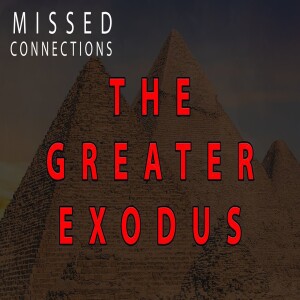
Saturday Oct 24, 2020
The Greater Exodus - Missed Connections
The Greater Exodus - Missed Connections

This Bible teaching from Founded in Truth Fellowship, possibly delivered by Matthew Vander Els, explores how the authors of the New Testament intricately weave their narratives about Jesus, or Yeshua, with the stories and themes of the Old Testament. The central argument is that these connections are not accidental but deliberate, intended to reveal a grand, unified story of redemption culminating in Jesus Christ. The teaching emphasizes that understanding these connections is crucial for grasping the true significance of Jesus and His mission.
Many readers, when engaging with biblical texts, often view them as isolated historical accounts. For instance, the stories of the Garden of Eden or Noah's Ark might be perceived merely as records of past events, without recognizing the deeper symbolic layers and connections they hold. This limited perspective, according to the teaching, can lead to missing the profound "hyperlinks and the patterns that the biblical authors left for us." These interwoven narratives expose a more extensive storyline throughout the Hebrew Bible, all pointing towards Yeshua.
The speaker uses the story of Noah's flood as an initial example. While it is a historical account of God's judgment and recreation, it also serves as a parallel to the creation in Genesis. Just as the earth was once covered in water and then dry land appeared, the flood brings about a reset of creation with Noah as a new Adam, having dominion over the animals. God's intention behind the flood was to correct the violence that had filled the earth. However, the narrative reveals that divine violence alone does not solve the problem of human violence, a motif that continues throughout the Old Testament. Noah's subsequent actions after leaving the ark, such as planting a vineyard, getting drunk, and becoming naked, echo the failings of Adam, highlighting a recurring cycle. This cyclical nature of human fallibility sets the stage for the arrival of Yeshua.
The teaching then shifts to the New Testament, focusing on how the Gospel writers intentionally portray Jesus. Matthew, in particular, is highlighted for presenting Jesus as the new and greater Moses. Matthew structures Jesus' teachings into five sections, drawing a direct parallel to the five books of the Torah given by Moses. Furthermore, Matthew emphasizes striking similarities between the childhoods of Moses and Jesus. Just as the evil King Pharaoh attempted to kill Moses through the slaughter of infants in Egypt [Exodus 1:22], King Herod sought to kill the infant Jesus through a similar act [Matthew 2:16]. The midwives who deceived Pharaoh [Exodus 1:17] find a parallel in the wise men who tricked Herod [Matthew 2:16]. Moses was hidden from Pharaoh [Exodus 2:2], and Joseph was told to hide Jesus from Herod [Matthew 2:13]. Both Moses and Jesus found refuge in Egypt [Exodus 2:3, Matthew 2:13-15]. These deliberate parallels underscore Matthew's aim to present Jesus as the prophesied "one likened unto Moses," the true prophet who would deliver the essence of the Torah in a way that would truly bless humanity.
The expectation after the Babylonian exile was a new Passover and a greater exodus, where God would redeem His people, establish a new Davidic king, and usher in God's kingdom. The New Testament authors argue that Jesus is the one leading this greater exodus, not a physical journey but a liberation into a new creation, a freeing from sin and death through His ministry, death, and resurrection.
For more Bible Teachings, click here.
Application for Everyday Life
- Recognize the Bible as a Unified Narrative: Understand that the Old and New Testaments are not separate books but interconnected parts of a single, overarching story of God's plan for humanity.
- Look for Deeper Meanings: When reading biblical stories, go beyond the surface-level historical account and seek the underlying themes, patterns, and connections to other parts of Scripture.
- See Jesus in the Old Testament: Recognize that the Old Testament foreshadows and points towards the person and work of Jesus Christ, the promised Messiah.
- Understand the "Greater Exodus": Grasp that Jesus' sacrifice and resurrection provide a liberation from the bondage of sin and death, a spiritual exodus that transforms lives.
- Live a "Redeemed Life": Embrace the freedom and new life offered through Jesus, striving to reflect God's image and participate in the divine community of love.
- Engage with Scripture Actively: Don't just passively read the Bible; meditate on it, digest it, and seek to understand the bigger story of salvation revealed within its pages.
References
- Exodus 1:17 https://biblehub.com/exodus/1-17.htm
- Exodus 1:22 https://biblehub.com/exodus/1-22.htm
- Exodus 2:2 https://biblehub.com/exodus/2-2.htm
- Exodus 2:3 https://biblehub.com/exodus/2-3.htm
- Matthew 2:13 https://biblehub.com/matthew/2-13.htm
- Matthew 2:16 https://biblehub.com/matthew/2-16.htm
- Matthew 17:1 https://biblehub.com/matthew/17-1.htm
- Luke 9:30 https://biblehub.com/luke/9-30.htm
- Luke 11:19 https://biblehub.com/luke/11-19.htm
- John 2 https://biblehub.com/john/2.htm
Books and Resources Mentioned
Note: This article contains affiliate links.
No comments yet. Be the first to say something!